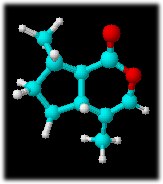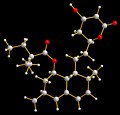
A rather common search on the sciencebase site seems to ask how to generate a molecular formula. Well, the method I use is to go straight to ChemSketch and fire up ACD/Dictionary, type in the name of the compound I want to produce and paste it into the ChemSketch window. That gives you the everyday 2D structure. A quick click of the “3D Viewer” button does what it promises to do and opens the molecule as a 3D view. At this point, it’s still flat and has to be optimised, so the “3D optimization” button is next. That renders the molecule as a three-dimensional molecular structure. Now, save as a mol file and as a ChemSketch structure.
Now, I follow one of several paths at this point depending on what use I am to put the molecular formula. If it’s to illustrate a scientific piece I’d often be simply using the 2D version. But, if I want something a bit flashier I’ll usually use the 3D view and tweak the settings to change background colour, add or remove hydrogen atoms, or re-render it as a space-filling or ball and stick molecule, depending on which format will best get across the chemical message.
Alternatively, I may shut ChemSketch altogether and re-open the mol file in Diamond from Crystal Impact, which can produce wonderful pseudo photographic quality molecular structures. And, if these aren’t good enough, the next step is to do a full 3D rendering in Pov-Ray, which provides scenic backgrounds, quasi-shadowing, and other wonderful effects to produce a beautifully metallic textured molecule hovering in space, for instance.




 Cellulite is of growing concern to a huge number of women and many consider different ways of reducing it including bariatric surgery or a tummy tuck liposuction procedure, diets and other methods, while others really couldn’t care less about the superficial dimpling of their subcutaneous fat. Moreover, it provides yet another example of the medicalisation of a perfectly harmless “condition” as exemplified by the description of “sufferers” as patients.
Cellulite is of growing concern to a huge number of women and many consider different ways of reducing it including bariatric surgery or a tummy tuck liposuction procedure, diets and other methods, while others really couldn’t care less about the superficial dimpling of their subcutaneous fat. Moreover, it provides yet another example of the medicalisation of a perfectly harmless “condition” as exemplified by the description of “sufferers” as patients.